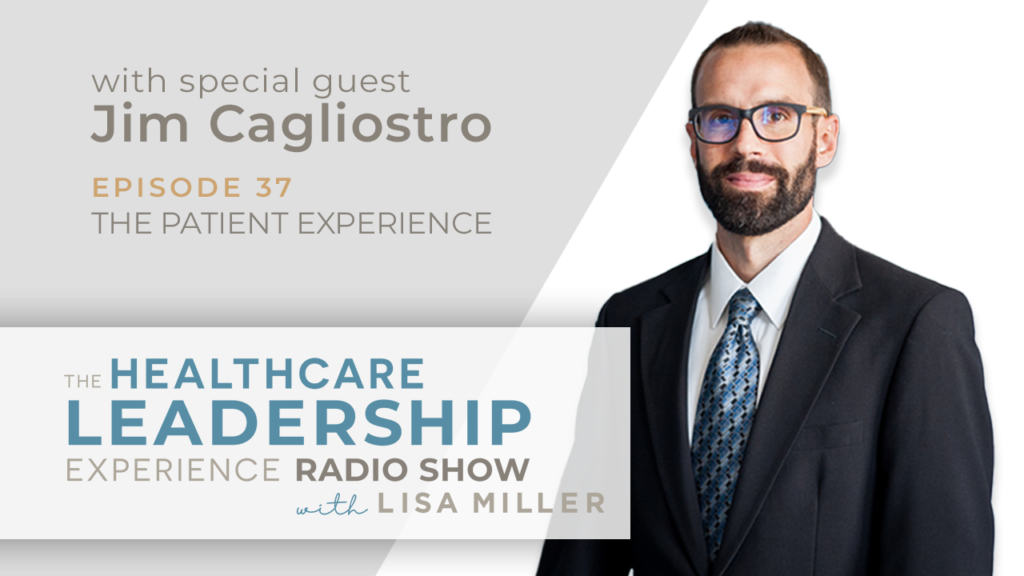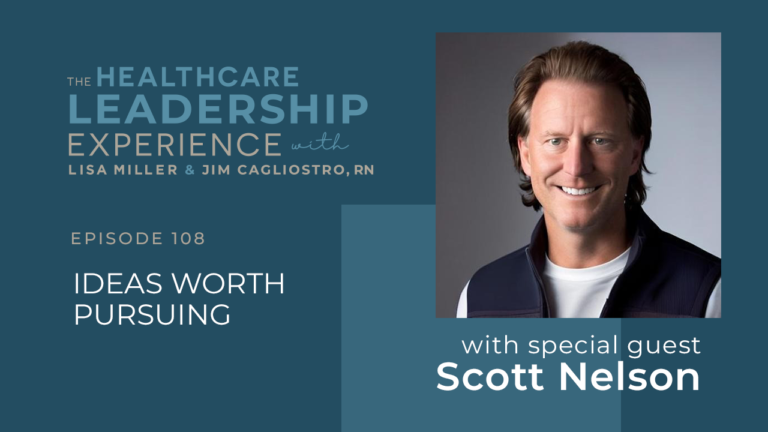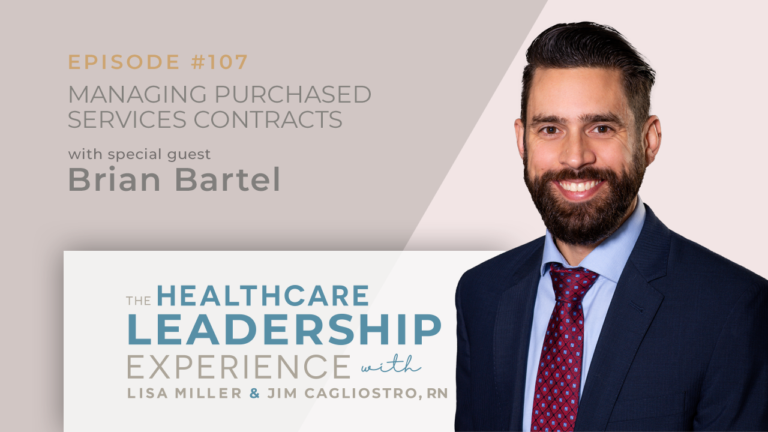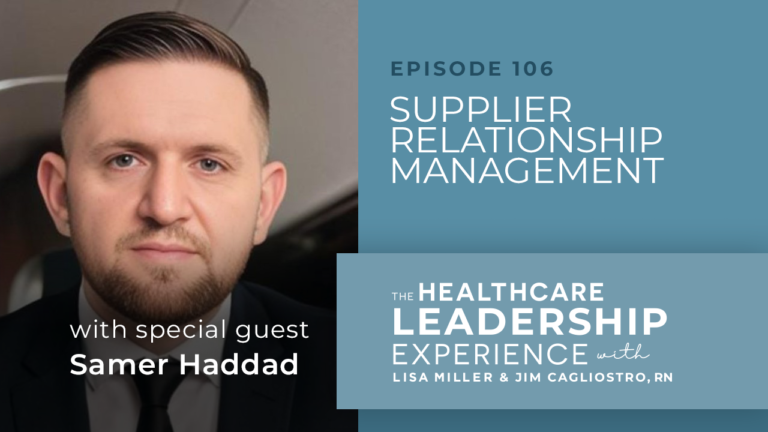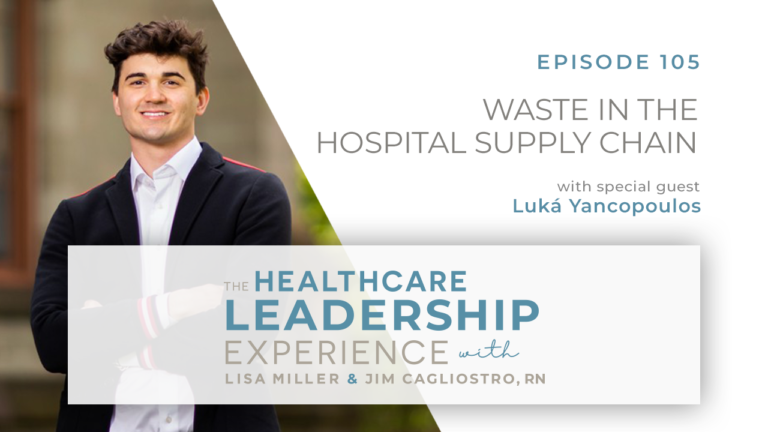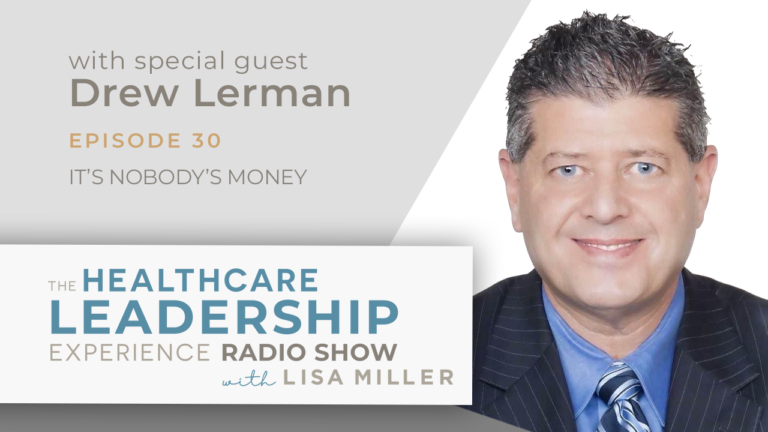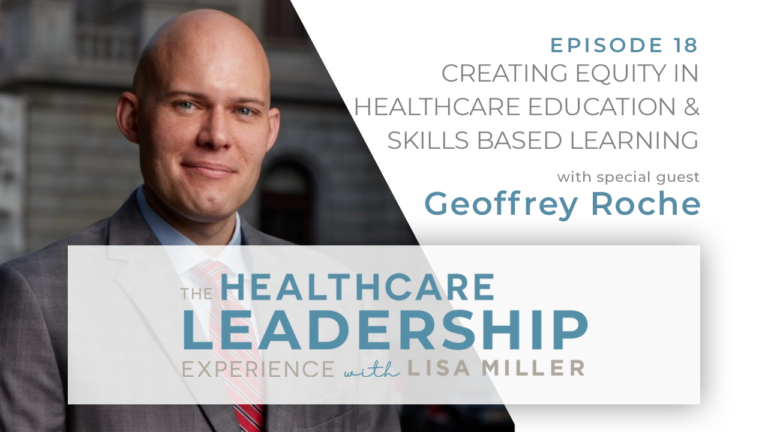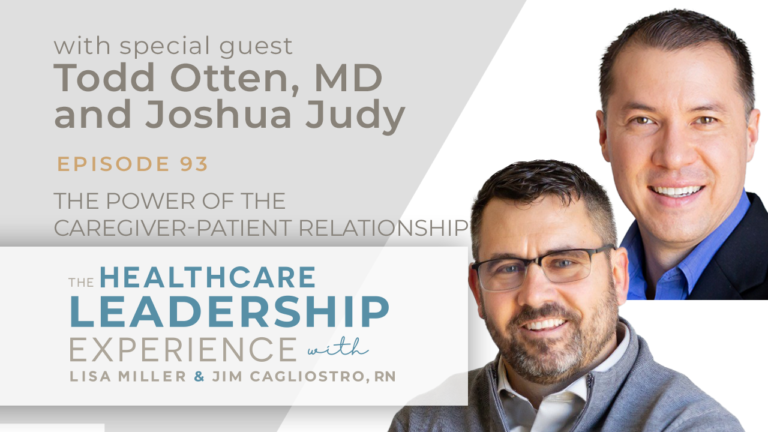The Patient Experience Doesn’t End at the Time of Discharge
In Episode 37 of The Healthcare Leadership Experience, Lisa is joined by Jim Cagliostro from VIE Healthcare. Together they discuss the challenges hospitals face in creating a positive patient experience.
As Jim comments, ‘’Many patients are realizing they do have a choice…ultimately your hospital’s ability to attract new patients and retain current patients .. might come down to your ability to provide an excellent patient experience. That might be the tipping point when patients are deciding where to go.’’
This episode is sponsored by VIE Healthcare Consulting® which has proudly helped hospitals save $772 million since 1999.
In this episode you’ll hear:
- Jim’s journey in healthcare, from athletic trainer to over 10 years of nursing experience, including critical care and PACU.
- Why healthcare needs to redefine the patient experience. ‘’It’s not simply making patients happy, it’s about providing safe, high quality care in an environment that promotes healing and in a way that positively impacts patients.’’
- Four key reasons the patient experience has historically been overlooked by hospitals. Hint, it is also ‘’simply hard to do.’’
- The importance of communication – and one key question that every hospital needs to answer –’’What are you going to do about the negative feedback?’’
- Why the patient experience should be a priority for all healthcare leaders. ‘’We’re meeting people at the worst time in their life going through a major health crisis, we need to acknowledge that.’’
- The ‘’triple whammy’’: how reimbursement, the rise of the smarter healthcare consumer and high deductible health plans are affecting the patient experience – and why healthcare leaders can’t take it lightly.
- The importance of communication at every stage of the patient journey. ‘’When there’s a lack of communication, it can bring anxiety for a patient.’’
- Why the patient experience doesn’t end at the time of discharge, and the cautionary story of Jim’s eight-month patient billing experience.
Connect with Lisa:
📧 lmiller@spendmend.com
📱https://www.linkedin.com/in/lisamiller/
Episode Transcripts
CLICK HERE TO DOWNLOAD THE PDF TRANSCRIPT
CLICK HERE TO OPEN THE TRANSCRIPT
Introduction (00:02):
Welcome to The Healthcare Leadership Experience Radio Show, with your host, Lisa Miller. Lisa is an entrepreneur, inventor, advisor, and founder of VIE Healthcare Consulting, the leading healthcare advisory and analytics firm, helping hospitals accelerate their margin improvement goals. Lisa loves to think differently and collaborates with leaders and their teams to solve challenges and to create new innovative approaches that impact the clinical and business side of healthcare. Our show will bring you leaders and innovators within healthcare and across multiple industries. Be a part of the discussion that will give you a unique perspective, deep insights, and roadmaps to successfully help you navigate the clinical, financial, and operations of healthcare. Your show starts now.
Lisa (00:49):
Hello, you’re listening to The Healthcare Leadership Experience Radio Show on HealthcareNOW Radio. I’m your host Lisa Miller. Today on our show, we have a special guest, Jim Cagliostro. He’s from VIE Healthcare. He’s our clinical operations improvement expert and consultant, but he has a real long and vast experience in nursing, and we’re gonna have a great conversation today about the patient experience.
Just a little bit about Jim. He started working at VIE since 2018. However, uh, he has seven years of critical care experience at Hershey Medical Center and Stanford Hospital and Clinics, and three years of PACU/perioperative/surgical experience in New Jersey. And I am going to let Jim share a little more about himself and his career and why nursing. Jim, welcome to the show.
Jim (01:40):
Thank you for having me. I’m looking forward to it.
Lisa (01:42):
So Jim, tell us a little bit about yourself.
Jim (01:44):
So, well, I-I always have to mention my family. I’m married with three wonderful girls, another girl due in May. And yeah, I’ve been a nurse since 2007 and I got into nursing because…actually I started out as an athletic trainer in high school, and I really like the human body and the healing process and really working with people. I love working with people, I love the bedside, and there was just, going into college, people said, “Hey, there’s gonna be opportunities in nursing,” at least in terms of work. So I began that process and I’ve loved it ever since.
Lisa (02:14):
So in terms of your career path, right outta Messiah, what was your first nursing position?
Jim (02:20):
There were a few of us that actually … We did clinicals at Hershey Medical Center. So there were I think seven or eight of us that began work at Hershey Medical Center, and just a, a wonderful organization to begin nursing. And I look back at that time, I say, “We really learned a lot in, in the critical care area.” Um, they had a great new nurse program, um, that really trained and really helped people get a grasp of what nursing is all about. And then from Hershey, we did three years out in California at Stanford Hospital, which is another great facility, before coming back to New Jersey, which is home for me.
Lisa (02:53):
That’s great. So, uh, for everyone listening, yes, he will have four girls. (laughs) So, congratulations.
Jim (03:01):
We’re excited, but yes-
Lisa (03:02):
Yeah.
Jim (03:02):
… people have warned. Yes. (laughing)
Lisa (03:04):
So we’re gonna talk today about the patient experience. So what is the patient experience definition or what does that mean to you, Jim?
Jim (03:11):
Sure. So when you ask any healthcare professional about the patient experience, you’re probably gonna get a whole bunch of different answers, because it’s, it’s a term that hasn’t really been defined well. But I look to a book that I read, that I strongly recommend, called Service Fanatics by Dr. James Merlino. He’s with, uh, Cleveland Clinic. And he mentions, and I’ll read one of his definitions here, he said, “The patient experience is everyone and everything people encounter from the time they decide to go to your hospital, until they’re discharged.” And I’d actually, we’ll talk about it a little later, but I’d take it even a step further than that. But I love that definition ’cause it reminds us that every employee in every department can have an impact on the patient experience. And I think a definition that I’ve enjoyed is really reminding ourselves what the patient experience is not.
Jim (03:59):
It’s not simply making patients happy, because there’s something more important in healthcare. It’s not just, “Oh, as long as we have happy patients.” I mean, I like the definition, it’s about providing safe, high-quality care in an environment that promotes healing, and in a way that positively impacts patients. So I, I don’t wanna ignore … Yes, we wanna make patients happy, but I tell my kids, I said, “It’s not job to be your friend all the time. Sometimes we have to do what’s right and what’s best for you.” So, so that’s how I’d kind of sum up the patient experience.
Lisa (04:27):
Yeah. I like that a lot because there’s been books about happy customers, (laughs) you know, happy patients, and, uh, yeah, of course we want that experience of saying, “Okay, this has been a, a great experience. They’re, they’re happy,” but I love the, your definition because safety, high quality, maybe even proactively thinking about the future, the transition, the going home, and the connections, I, I think that’s more meaningful than happy patient.
Jim (04:56):
100%. And you mentioned that proactive, and that’s a huge piece of it. We’re so used to this reactionary customer service, but we have to be proactive. Absolutely.
Lisa (05:05):
So, we’re getting into some areas that I’m also equally passionate about it as well as you. And it seems like in the past, that historically patient experience has been overlooked. And I would wonder why you think that — and have you seen some changes and are we there completely yet? So why has it been overlooked? Ha- … Do you see changes now moving in a better direction, and how far do we … What’s the gap to get to where we need to?
Jim (05:30):
I definitely agree that it, it has been overlooked. I’d come up with a few reasons, and the listeners, you know, might come up with some others. But the first thing that comes to mind is hospitals have not historically been paid for the patient experience. CMS has reimbursed, at least in the past, on a fee-for-service basis. And your listeners will know that that’s changing. That’s been changing for years, that there is more of an emphasis and a focus on the quality of care delivered, not just, “Okay, you performed a surgery, here’s your reimbursement.”
Jim (05:59):
Another thing is, and I’m guilty of this, healthcare workers often, we’ll consider our job done if the patient went through their surgery, they recovered, and we send them home. “Great. My job is successful.” But we need to get beyond that and, and think about exceeding expectations and providing really a great experience.
Jim (06:17):
Another reason why I think it’s been overlooked is that, uh, s-simply, i-it’s hard to do. I-i-it’s a hard thing. It requires time, effort, resources, really a commitment from leadership, buy-in from the organization, um, a, a number of things, and, and it’s just, it’s simply hard to do. And I think probably the last thing I’d say that’s maybe the biggest obstacle is, at least historically, patients have thought they don’t really have any other place to go. The-they feel like they don’t have a choice, whether it’s because their doctor refered them to a place, and, “Well, that’s the place I have to go,” or insurance. And sometimes if insurance doesn’t cover my surgery at one hospital, I have to go to this hospital.
Jim (06:55):
And so they feel locked in and then hospitals, I think healthcare workers, we can get the mindset, “Well, you’re gonna come back to us regardless because your insurance covers this hospital,” and that’s changing too. But anyway, but those are a number of reasons and I’m sure there’s others that people could come up with, why the patient experience has been overlooked.
Lisa (07:12):
Yeah. A-and I think that it, there’s a lot more focus around the patient experience. And I see it, uh, you know, with the, with CEOs, COOs, leadership, realizing that it’s, it’s such a key factor for, you know, competition, for reimbursement, like you said — and also their brand too, right? Of being the place where, you know, the patient experience matters or, you know, the patient healing matters. And so they’re kind of incorporating their brand, their competitiveness, and then of course reimbursement. And it is hard to do, like you said.
Lisa (07:49):
You know, it really requires a dedication to looking at metrics. And I think something that everyone’s really uncomfortable doing is hearing what they’re not doing right. And that involves really, I think even beyond surveys, and I know healthcare’s doing that more, but really getting the feedback at bedside after looking at online reviews and really saying, like you said it, this isn’t because they just have to come here. This is, “Wow, there’s something really going on this floor.”
Lisa (08:19):
Or if you look at some of the online reviews sometimes, and I do this for some projects, I think there’s themes. It’s communication. It’s, of course, waiting, but I, I think that’s, you know, unfortunately that’s just gonna be tough now, but I, I always … There’s this theme of communication always. Right?
Lisa (08:35):
So Jim, ho-, what are your thoughts about that? About communication from a nursing perspective, or a physician, or even just anything in the hospital, any place in the hospital? From picking up a phone and having someone on the other end-
Jim (08:45):
Absolutely.
Lisa (08:46):
… maybe not being, being patient? (laughs)
Jim (08:49):
Well, I remember that that’s one thing that you brought to my attention. I’ve really been i-impressed by how much you can gather just from Google reviews, an-and see what people are saying and, and to look for those recurring themes. An-and you mentioned communication, you know I’m passionate about that. I tend to be an overcommunicator, sometimes to a fault, but I know a-as a patient, I’ve been on the other side, in the bed receiving care, and you see sometimes when there’s a lack of communication, it can bring anxiety for a patient, it can bring confusion, and we wanna do everything we can to provide education for patients. We want to give them opportunities to ask questions.
Jim (09:25):
I know sometimes healthcare providers, nurses in particular, a-a-are running from patient to patient and so busy. Sometimes they don’t stop to take the time to make sure that what they’re communicating to patients is understood, but also to stop and say, “Hey, do you have any questions? Are there any concerns that you have?” So I, I, I think communication is a huge piece that … Well, I, I think on your last radio show, what was it? Dr. Vallee? I’m probably saying-
Lisa (09:49):
Vallee, yeah.
Jim (09:50):
He said the idea of under-promise and over-deliver. And so a lot of times we might make a promise and we don’t follow through with it. So that’s important, is that what we’re communicating, are we truly following through with it, but also just the fact that we are communicating. Can I share one story, Lisa, related to this?
Lisa (10:06):
I, I would love you to, please.
Jim (10:08):
So this goes back to, kind of along with the feedback, but also the communication. And I say in terms of improving the patient, uh, experience, we need to listen to feedback, an-and you hit the nail on the head when you said not just the good feedback, we all love to be praised, but what about the negative feedback? Okay, great. Not just listen to the negative feedback, but what are you gonna do about that negative feedback?
Jim (10:31):
So the story I have is when our first daughter, Brooklyn, was born, we were out in California, and I won’t share the name of the hospital, but this is a good thing for, for the hospital, but it doesn’t sound good when you start. I’m holding my daughter, Brooklyn, and I was given an update. She was given her shot of vitamin K, which is standard globally for babies when they’re born, and I’m holding Brooklyn, rocking in the glider, and another nurse comes up ready to give her a shot.
Jim (10:54):
And I said, “Oh, what is that?” And she said, “Oh, it’s, it’s her dose of vitamin K.” And I said, “Well, hold on a second. I think she already received it.” And the nurse said, “No, no, she didn’t get it yet.” So I had to clarify and direct her to the nurse who told me that she received it. And sure enough, if I wasn’t there holding her, Brooklyn could have gotten a second dose of vitamin K. An-and that, that was really upsetting to me, especially as a first-time father, you know, your, your emotions are all o-on high. And so I remember being very upset about that.
Jim (11:20):
But I also remember, a day or two later when we were home, I got a phone call from the manager and the manager was apologetic, said, “Hey, we understand there was an issue,” and she listened to me, and I was able to, to vent a little bit, yes. But also to explain to her, “Hey, I’m a nurse. I understand that there’s difficulties, there’s challenges we have, but this is a mistake or a potential mistake that should not even come close to happening again.”
Jim (11:45):
And so she listened, and I wanna say at least 30 minutes, maybe up to an hour, we sat and we talked, and I don’t even know if they did anything about it. I, I’m assuming they did. But the fact is, I felt heard. And the fact that I felt that she was listening to me, and she was asking me questions, and taking that feedback, that was a huge thing. So she turned a potentially very negative experience into a positive experience for the patient. An-and I, I just love sharing that story because it all comes down to listening to that feedback and communicating.
Lisa (12:15):
That’s a great story, because most of the times they just would’ve wrote it off, o-or maybe just did, you know, a follow up call and say, “We’re sorry.” But the fact that she took so much time and asked you questions is genuine and it was authentic. And I think that’s what’s really the heart of a patient experience, is getting to those issues, but reaching out, not because it’s a check the box or we’re trying to not have a negative survey, but doing it from an authentic place. I think that’s really powerful and I think that’s where we have to be.
Lisa (12:50):
So if you’re just tuning in, you’re listening to The Healthcare Leadership Experience Radio Show on HealthcareNOW Radio, and I’m Lisa Miller, your host. Today I’m joined with Jim Cagliostro, and we’re talking about the patient experience. The show is sponsored by VIE Healthcare Consulting, a leading healthcare advisory analytics firm, helping hospitals accelerate their cost savings and margin improvement goals since 1999. You can learn more about VIE Healthcare at viehealthcare.com.
All right, Jim. We have a lot more to talk about in terms of the patient experience, and I love your story. How do you convince healthcare leaders that the patient experience should be a priority?
Jim (13:30):
This is another thing I’d like to use an example, where say you go to a restaurant, and you arrive to the restaurant, the-there’s no parking. The hostess is rude. There’s a long wait. You’re just uncomfortable. It’s a cold waiting area. And this is even before you’ve sat at a table, you’re already miserable. And then once you’re seated, it’s overcrowded. Your waiter is rude. You have a long wait for your food, that eventually comes out cold. And then to top it all off, you end up with a bill that’s much m-, higher than what you think is reasonable for the experience you were provided. And so my question I ask people is, would you ever return to that restaurant? Would you, Lisa, would you ever go back to that?
Lisa (14:07):
No, of course, that’s a great stor- … It’s a great example.
Jim (14:10):
And then would you even recommend that to any friends or family?
Lisa (14:14):
No. No. Of course not.
Jim (14:15):
And maybe to enemies? But yeah, we won’t recommend?
Lisa (14:15):
Yeah. (laughs)
Jim (14:16):
So imagine that. And now that’s us going out and looking for a nice time, a good time. Now imagine you’re in a situation where you’re not feeling well. You’re sick, you have some issues going on, pain, whatever it is. You’re in the middle of a major health crisis and you’re driving up to that local hospital. The last thing you want is to experience all those negative things that could be avoided. A-a-and so I, I look at this as I think we need to remind healthcare leaders that, yes, it’s very challenging ’cause we’re not trying to treat people to a nice dinner. We’re meeting people at maybe the worst time in their life, going through a major health crisis. So it is a very real challenge. We need to acknowledge that.
Jim (14:54):
But with that challenge comes a very real opportunity to do some amazing things, to provide a positive patient experience where people could say, “Hey, wow, that was impressive. I didn’t expect that,” where we go above and beyond to give the patient a great experience. My … I think of, you recommended this book, Lisa, I don’t know if I ever mentioned to you, but it was Joey Coleman, Never Lose a Customer. I dunno if you, I, I know you-you’ve read that-
Lisa (15:20):
Yes.
Jim (15:20):
… but, um, there’s a quote from there that he says, “If you’re providing remarkable customer experience, customers will continue doing business with you and they’ll bring their friends along too.” And so I remember he, he kind of spends time talking about, “That’s your best advertisement,” is patients who’ve gone through your hospital, gone through your health system, they’ve had a great patient experience. And now they’re gonna go tell their friends, and it’s free. It’s your best advertisement. You don’t have to pay for it. They’re gonna say, “Hey, I had a great experience at this hospital. You should go there too.” So that, that’s another reason I think we can convince healthcare leaders.
Jim (15:53):
We’ve mentioned the reimbursement piece. Healthcare leaders are aware that reimbursement is, um, a lot of reimbursement is based on the safety of the patient, the quality of the care you provide, and patient satisfaction, and all those things. As you remember, that’s how I kind of summed up the patient experience. Reimbursement is largely based on the patient experience. So we can’t take it lightly. And, and if I can share one more piece that I think is growing, a, a reason why hospital leaders need to take the patient experience very seriously is this rise of high deductible health plans. This rising financial responsibility is falling more and more on the patients.
Jim (16:33):
And so as a result of that, we have patients becoming smarter healthcare consumers. They are using things like the new price transparency rules, and they’re looking up prices for an x-ray or for a certain lab. They’re using websites that have been around, like Leapfrog, Healthgrades, the Hospital Compare website on medicare.gov, even Google reviews, uh, like you mentioned. And so we need to convince hospital leaders that many patients are realizing that they do have a choice. And so ultimately your hospital’s ability to attract new patients and to retain current patients, it might come down to your ability to provide an excellent patient experience. Tha-that might be the, the tipping point when patients are deciding where to go.
Lisa (17:13):
That’s fantastic. Jim, I’m gonna throw you a little curve ball for a minute. We have a crisis with staffing and you know, with COVID and the wait times, we’ll talk, you know, just specifically talk about maybe either the ER as an entry point or maybe one of the floors. So now we have staff that’s stressed and they’re doing their best, and then you have a backlog. And so you almost have this storm of patients who are waiting, they’re frustrated, like you said, with the example of the restaurant, and then you have a, probably an exhausted workforce. What do we do? Now, this is, I’m throwing a real big curve ball at you, ’cause if you can answer this question, you’re gonna have a flock of hospitals calling you (laughs)-
Jim (17:56):
That’s right. That’s right.
Lisa (17:57):
… for consulting work, but what do we do?
Jim (18:00):
At least, I, I think that’s a great question, uh, with not an easy answer. And I believe at least at face value, we need to do what we can here and now today. And so I think it does come back to that communication piece where yes, I-I’ve been there, where you’re waiting and it seems like you’re waiting way too long. And healthcare workers are stressed, they’re overworked. And when I talk about communication, I mean, explaining to patients … I mean, I love the phrase, “I’m doing my best.” And even I, I’ve heard people say, “Oh,” if the doctor’s late, or if, or, or if the nurse is late coming to your room, you’re saying, “Hey, they’re spending time with the patients we’re with now. But when they come, they’re gonna give you all the time that you need.” A-a-and so that fuel-
Lisa (18:40):
I love that wording that you’ve s-, uh, and I want you to talk about that again or say it again. I love that wording because that’s something so simple. Can it really be embedded in a patient’s thinking or thought process?
Jim (18:52):
Yeah. So the setting is probably all too common, where, I forget where I read it, but where a doctor is late and, and the response for me as a nurse could say, “Oh, you know, Dr. So and So’s late again.” And, and that does not provide much confidence to the patient and it does not provide a good patient experience. But instead of saying, “Oh, the doctor’s late again,” you could say, “Well, so and so is in with another patient, they’re making sure, you know, that they have everything done there so that when they come to you, they can spend as much time as they need. You’re not gonna be rushed. You’re gonna have all the time that you need to ask questions and to address your issue.”
Jim (19:28):
That provides such a different experience for the patient, even though the same thing, “Hey, the doctor’s 10 minutes late. The doctor’s 10 minutes late,” but it’s how we communicate to patients to try to help them understand and to try to lower their anxiety. I mean, that’s one thing I’m big on, is giving them options when we can, but really just communicating with them, making sure they understand the situation.
Lisa (19:48):
And I wonder if there’s a opportunity to think outside the box or just brainstorm some simple solutions. So I’m gonna give a story and maybe a solution as you were speaking.
Jim (19:59):
Right.
Lisa (19:59):
Uh, my daughter was in a hospital and she had to stay several nights, but they had a young man who would come in and, you know, traditionally pediatrics are far more, I think, thoughtful, and they do things very differently than other floors. You wonder if they should, they should take some of the things that they’ve done in pediatric floors and bring it to the geriatric floors-
Jim (20:20):
Absolutely.
Lisa (20:20):
… ’cause I think there some similarities, ’cause I take care of my mom and, uh, young kids-
Lisa (20:24):
… and there’s a lot of similarities.
Jim (20:25):
Yeah.
Lisa (20:26):
But you wonder like, “Why just pediatrics? Bring it to the geriatrics.” So, and everyone was great, very thoughtful, but they had this young man come in and he just would sit by my daughter’s bedside and just talk to her, and just … He would say like, “Do you need anything?” And so I was just like, “Okay, what’s your story?” And he’s like, “Oh, I’m in college and I,” he wants to either go similar to you physical therapy or thinks pre-med. And, and so he, you know, he’s doing it a volunteer work and he’s sitting bedside and he was able to be a liaison to say, “Okay, well, do you need something to drink? Or does your daughter need anything?” And he could go, he’s got a certain level of autonomy where he could grab some food or he could be a liaison. “You have a question, let me go get an answer.”
Jim (21:11):
Yeah.
Lisa (21:11):
I thought, “That’s brilliant, and …” But why does it have to be there? Like I wonder if you could transfer that to the ER, where people are waiting, waiting, waiting, when sometimes maybe there is somebody that’s nonclinical, “How you doing, Jim? Do you need something to drink? Do you need to go to the bathroom? Or can I help you with something? You know, yeah, we have a wait time.” What if it’s just some simple intervention that doesn’t have to be another nurse or … I just wonder, we just don’t think outside the box enough.
Jim (21:36):
Yeah. Yeah. I’d agree. And that reminds me of, uh, I, I, I think it helps for us to recognize in healthcare that when we have a patient that we’re caring for, we can’t just view it as this isolated interaction, and, and then we’re sending ’em out the door and we’ll never see ’em again. That may be the case, but if we approach it more like, “Hey, these patients, we have a potential long-term relationship with this patient. Let’s do everything we can and treat them like a person, show our humanity, and address their humanity, and treat this like a long-term relationship,” ’cause it very well may be a long-term relationship if they return for more care in the future.
Lisa (22:12):
So we have a couple of minutes to wrap up. So I’m gonna do a combo question for you-
Jim (22:16):
Right.
Lisa (22:16):
… maybe some ideas of how we can improve the patient experience, and then wrap it up with why it’s sometimes good to have an outside consultant to give a hospital feedback.
Jim (22:27):
Absolutely, absolutely. Well, I’ll try to hit, uh, kind of big picture ideas in terms of how we can improve the patient experience. And I mentioned the one about considering the long-term relationship that we may have with patients. I think that kind of shifts your perspective i-in a positive way, but also, uh, w-we mentioned it early on, recognizing that every single patient interaction is an opportunity to either help or harm the patient experience. Also, in that Service Fanatics book by Dr. Merlino, he talks about building a patient-centered culture. And sometimes that’s a challenge. If the culture of a health system is not good, you have to shift that.
Jim (23:02):
And a big part of that is appointing, and I think most hospitals have done this well, appointing a person, a patient experience officer, or whatever you want to call it, that’s responsible for making sure we have this patient-centered culture. And then you already touched on the idea of being proactive. We shouldn’t just be reactionary in terms of, “Oh, there’s an issue. Let’s put a Band-Aid over it.” No, let’s get deeper and try to figure out, “What are these recurring issues. Let’s try to address them before they even happen.” A-and so those are kind big picture things.
Jim (23:31):
And I do wanna mention the one thing, ’cause I know we’re running out of time, but I mentioned about the patient experience even continues after discharge, and people might say, “Well, what do you mean by that?” And I said billing. Billing is a huge thing that, that I’ve gotten more passionate about because my wife and I had a terrible experience at a very reputable facility that started in the billing office where they weren’t gonna let us register unless we paid them. But we knew insurance was covering 100%, and then it took us seven or eight months to get that money back. And so the patient experience didn’t end until eight months after I was discharged from the hospital. And so we as healthcare providers need to make sure we’re simplifying the billing process.
Lisa (24:08):
I think that we should have another show on the billing-
Jim (24:12):
Yeah.
Lisa (24:12):
… process, because you could have a phenomenal experience and that billing process is horrible. I’ve experienced a very, something similar with my mom, and in trying to get the money back. And I don’t think that leaders, healthcare finance people understand that as a pain point. And I think we put ourselves in our own shoes, but we’ve got people, maybe they don’t have a, a higher degree of literacy or understanding, and they call, you know, and they’re already feel like they’re out of sorts. They can’t, you know, have that conversation, or they feel intimidated, or all the things that unless we are in their shoes completely, there’s no way that someone in finance can understand there’s different literacy levels. There’s different questioning about the bill or even feeling like they can pay it, or that someone’s gonna yell at them, or not be understanding. I think there needs to be a complete reinvention around-
Jim (25:07):
Absolutely.
Lisa (25:07):
… patient billing. I think we should have a separate show about that, because I think that’s a pain point. I also think discharge is a pain point, and then once they get home. Jim, this has been a fantastic show and I, hopefully, we could do part two? (laughs)
Jim (25:22):
I would love to. Yes.
Lisa (25:23):
Yeah. So I appreciate you being on the show. And if you wanna learn more about Jim’s work, you could reach out to me. Also, Jim’s very active on LinkedIn and you could see what he’s talking about and what he’s sharing, but he is very passionate about the patient experience and can help your organization if you’re interested in learning more about his work.
Lisa (25:41):
Thank you for listening to The Healthcare Leadership Experience Radio Show on HealthcareNOW Radio. I’m Lisa Miller, the host, please join us here on HealthcareNOW Radio. Every day, our show is at 5:00 AM, 1:00 PM, and 9:00 PM Eastern Standard Time. And we’re also on other podcast apps. You can listen to other great shows on HealthcareNOW Radio like Health UnaBASHEd, The Virtual Shift, Payment Matters, and others.
Jim, thank you, and we look forward to, uh, hearing more from you.
Jim (26:08):
Thank you.
Outroduction (26:10):
Thank you for joining Lisa Miller for this episode of The Healthcare Leadership Experience Radio Show, sponsored by VIE Healthcare Consulting. If you enjoyed the show, subscribe so you can automatically get notified when new shows premier weekly, don’t forget to leave us a review so more healthcare leaders like you can discover us.
This show is on HealthcareNOW Radio, Apple Podcast, Stitcher, Spotify, Pandora, and other major podcast platforms.
To reach out to Lisa personally, you can join the conversation on LinkedIn, where Lisa continues to have discussions on the business of healthcare. You can find links to Lisa’s other social platforms in the show notes or at viehealthcare.com.
The Healthcare Leadership Experience Radio Show is the think differently communication for healthcare leaders and we are honored to have you tune in. Join us next week for another episode of The Healthcare Leadership Experience Radio Show.
